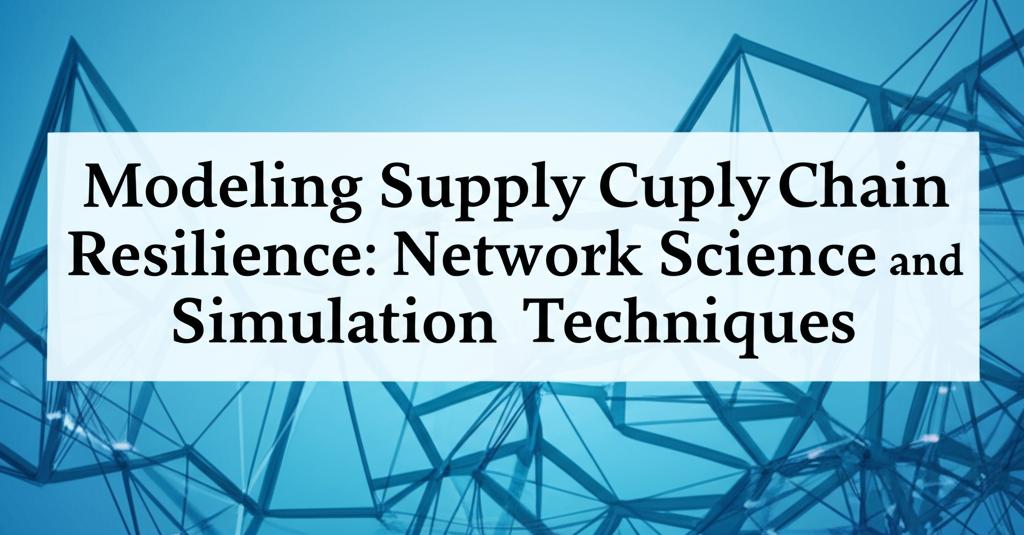In today's increasingly volatile global landscape, supply chains face unprecedented complexity and are frequently exposed to disruptions ranging from geopolitical tensions and extreme weather events to pandemics and economic instability. Consequently, building and maintaining supply chain resilience – the ability to anticipate, withstand, adapt, and recover from disruptions – has become paramount for business continuity, economic stability, and maintaining competitive advantage. Advanced modeling techniques, particularly those drawing from network science and simulation, are crucial tools for understanding vulnerabilities and designing more robust supply chain systems.
Network science offers a powerful lens for analyzing the intricate structure of modern supply chains. By representing supply chains as networks – where entities like suppliers, manufacturers, distributors, and retailers are nodes, and the flows of goods, information, and finance are links – we can gain deep insights into their topology. This approach allows for the identification of critical nodes (entities whose failure would disproportionately impact the network), vulnerable links, and potential bottlenecks. Complex network theory helps model how disruptions propagate through the system, such as the "ripple effect" where a failure in one part cascades through interconnected entities. Understanding the network's structural properties, like its degree of centralization or decentralization, helps assess inherent vulnerabilities and strengths. While powerful for understanding structure, network science models can sometimes be static or lack detailed operational dynamics.
This is where simulation techniques provide complementary strengths. Simulation allows for the dynamic modeling of supply chain operations over time, capturing variability, uncertainty, and the complex interactions between different elements. Techniques like Discrete-Event Simulation (DES), Agent-Based Modeling (ABM), and System Dynamics (SD) are widely used:
- Discrete-Event Simulation (DES): Focuses on modeling processes as sequences of events, useful for analyzing throughput, resource utilization, and lead times under various conditions.
- Agent-Based Modeling (ABM): Simulates the behavior and decision-making of individual autonomous entities (agents) within the supply chain and observes the emergent system-level behavior resulting from their interactions. This is valuable for understanding coordination, collaboration, and the impact of individual policies.
- System Dynamics (SD): Concentrates on feedback loops, delays, and stock-and-flow structures to understand the behavior of the entire system over time, particularly useful for analyzing phenomena like the bullwhip effect or the long-term impact of strategic decisions.
- Monte Carlo Simulation: Uses repeated random sampling to model uncertainty in variables like demand or lead times, helping to understand the range of possible outcomes and associated probabilities.
Simulation enables organizations to conduct "what-if" analyses in a risk-free virtual environment. They can test the effectiveness of different resilience strategies – such as holding extra inventory, securing backup suppliers, increasing flexibility, or enhancing visibility – before implementing them. By simulating various disruption scenarios (e.g., supplier failure, transportation delays, demand spikes), decision-makers can better predict the impact on key performance indicators like costs, service levels, inventory levels, and recovery times, allowing for data-backed contingency planning.
The most effective approaches often integrate network science with simulation. Network analysis can define the structure and critical points of the supply chain, which then becomes the foundation for dynamic simulations that explore operational behaviors and test resilience strategies under various disruptive events. This combined approach provides a holistic view, encompassing both the static structure and the dynamic performance of the supply chain.
Current trends point towards incorporating more advanced technologies like Artificial Intelligence (AI), machine learning, Big Data analytics, and Digital Twins into these modeling efforts. AI can enhance predictive capabilities for demand forecasting and risk identification, while digital twins create a dynamic virtual replica of the supply chain for real-time monitoring and simulation. These advancements promise even more sophisticated tools for proactively managing risks and designing inherently resilient supply chains capable of navigating future uncertainties.
Ultimately, leveraging network science and simulation techniques empowers businesses to move beyond reactive problem-solving. By proactively modeling, analyzing, and testing their supply chains, organizations can identify weaknesses, evaluate mitigation strategies, and build the necessary agility and robustness to thrive despite the inevitable disruptions of the modern world.

